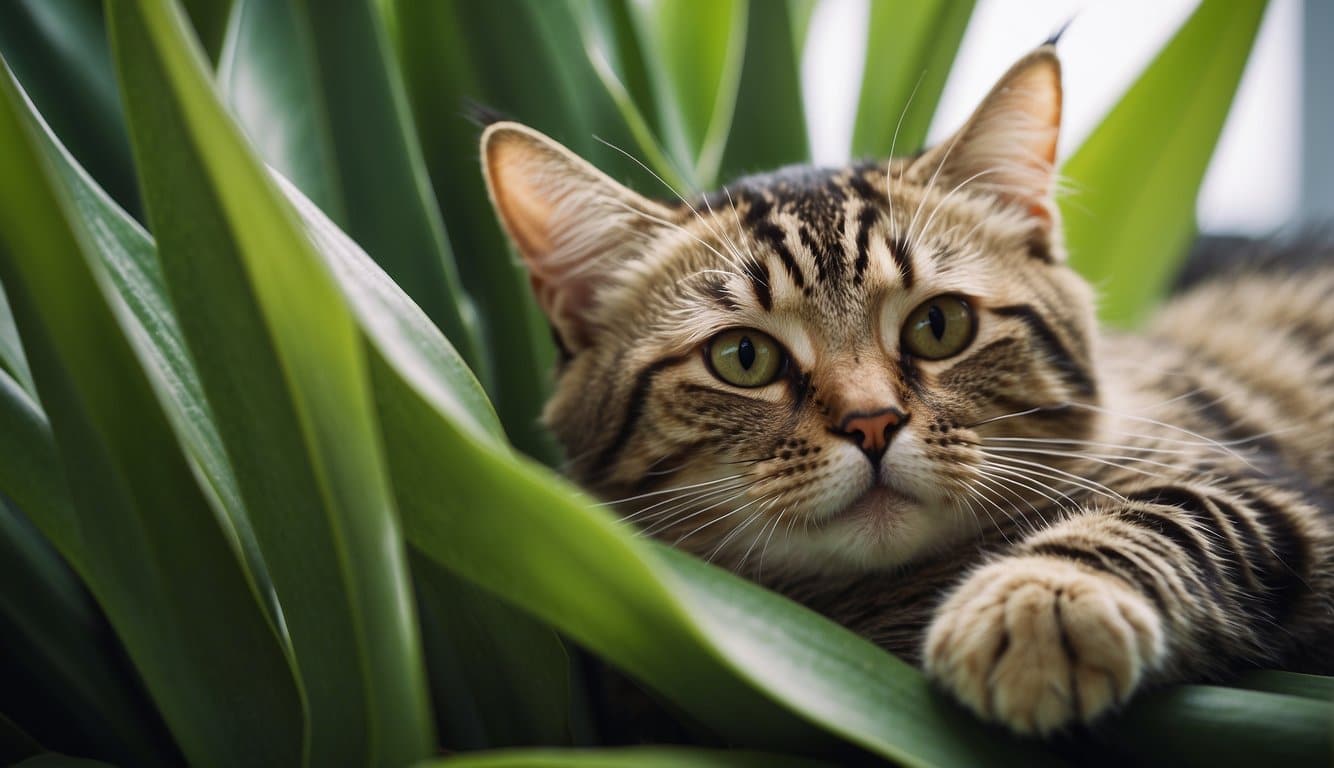Toxicity of Snake Plants to Cats
When it comes to your feline friends and snake plants, it’s crucial to be aware that these common houseplants are indeed toxic to cats due to specific chemical compounds they contain.
Chemical Compounds
- Saponins: Snake plants contain natural chemicals known as saponins. These are the toxic substances responsible for the plant’s defense against pests.
Reaction to Ingestion
If your cat nibbles on a snake plant, you might see the following reactions due to its toxic nature:
- Oral Irritation: Swelling and numbness of the tongue and lips, excessive drooling.
- Gastrointestinal Symptoms: Nausea, vomiting, and diarrhea are common signs of saponin ingestion.
- Lethargy: A less obvious but concerning sign is a decrease in your cat’s energy levels.
If you observe these symptoms or suspect that your cat has ingested snake plant, seek immediate veterinary assistance. For more detailed information, visit ASPCA’s Snake Plant page.
Symptoms of Snake Plant Poisoning
When your cat ingests parts of a snake plant, certain symptoms may arise, indicating potential poisoning. These symptoms primarily involve gastrointestinal issues and dermatological reactions, which you should not ignore.
Gastrointestinal Issues
Your cat may experience a range of digestive discomforts after chewing on a snake plant, including:
- Nausea: A feeling of sickness with an inclination to vomit.
- Vomiting: The forceful ejection of stomach contents through the mouth.
- Diarrhea: Frequent loose or watery bowel movements, which can lead to dehydration.
If these symptoms persist, it’s imperative to seek immediate veterinary attention, as prolonged gastrointestinal upset can critically affect your cat’s hydration levels and overall health.
Dermatological Reactions
Contact with snake plant sap may occasionally cause skin irritation for your cat, such as:
- Redness: The affected skin area might appear redder than usual.
- Itching or Swelling: You may notice your cat scratching more than normal or areas of swelling.
What You Can Do to Prevent This Issue
Ensuring the safety of your feline friends involves careful selection and placement of indoor plants. The following strategies are crucial in preventing any harmful effects snake plants may pose to cats.
Safe Placement of Plants
- Elevation: Place your snake plants on high shelves or secure hanging planters, out of your cat’s reach.
- Barriers: Use safety gates or closed doors to restrict access to areas with snake plants.
Alternative Cat-Safe Plants
Explore these non-toxic plant options for a pet-friendly home environment:
- Spider Plant: A resilient plant that’s safe for cats and easy to maintain.
- Boston Fern: Offers lush greenery and is known for its non-toxic quality.
What to Do if Your Cat Eats Snake Plant
If your cat has ingested part of a snake plant, it’s crucial to know the correct first aid steps to take before professional veterinary care is available. These measures can mitigate the risk of more severe health issues.
Immediate Actions
- Remove Plant Material: Promptly clear any remnants of the plant from your cat’s mouth to avoid further ingestion.
- Offer Water: Give your cat water to drink which may help dilute the ingested toxins.
- Observe Symptoms: Look for signs of nausea, vomiting, or diarrhea, and note them for your veterinarian.
Professional Veterinary Care
- Seek Immediate Help: Contact your vet or an emergency pet clinic immediately, even if symptoms haven’t yet appeared.
- Follow Instructions: Your vet may provide specific instructions over the phone; follow these carefully while preparing to transport your cat to the clinic.
- Professional Assessment and Treatment: At the clinic, your cat can receive a thorough examination, diagnosis, and the necessary treatment, which may include medication to alleviate symptoms and absorb toxins.
Frequently Asked Questions
Concerns surrounding the safety of snake plants for cats can lead to a multitude of questions. As a responsible pet owner, being informed about these risks is crucial for the wellbeing of your feline friend.
What are the effects on cats who ingest snake plants?
If your cat ingests parts of a snake plant, they might experience numbness and swelling of the throat and tongue, potentially leading to gastrointestinal issues such as nausea and vomiting.
How can I identify if a plant is toxic to my cat?
To determine plant toxicity for cats, research and refer to authoritative resources. Plants like snake plants contain saponins, a natural compound that is a known toxin to cats.
What should I do if my cat licks a snake plant?
In the event your cat licks a snake plant, it’s crucial to respond swiftly. Cleansing their mouth gently and monitoring them for symptoms of discomfort is advised, followed by contacting a veterinarian for professional guidance.
Are there any symptoms of poisoning I should watch for in cats after they’ve been near a snake plant?
After your cat has been near a snake plant, vigilance is key. Watch for signs of distress including:
- Excessive drooling
- Decreased appetite
- Visible discomfort or unusual behavior
Which houseplants are known to be safe for feline companions?
Certain houseplants are recognized as safe for cats, such as spider plants and Boston ferns. These plants do not possess the toxic properties that entail health risks like those found in snake plants.
How does snake plant toxicity compare between cats and dogs?
Snake plant toxicity can similarly affect dogs as it does cats.
Both cats and dogs are susceptible to the plant’s toxic saponins, though individual reactions may vary according to size and overall health.


